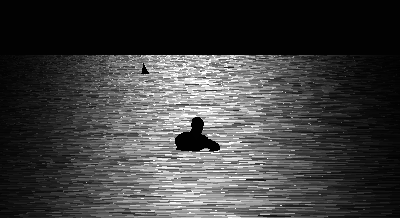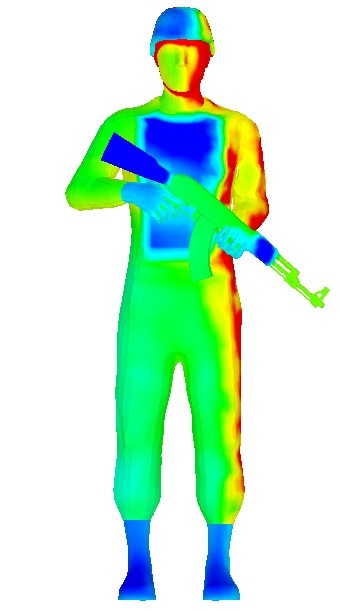ThermoAnalytics' Human Thermal Extension complements our infrared analysis tools, MuSES. There are numerous applications where understanding the infrared signature of a  human is important: from finding shipwrecked boaters in the open sea to designing optimized uniforms, as well as predicting the onset of heat stroke for a range of body sizes, activity levels, and weather patterns.
human is important: from finding shipwrecked boaters in the open sea to designing optimized uniforms, as well as predicting the onset of heat stroke for a range of body sizes, activity levels, and weather patterns.
ThermoAnalytics’ human model computes the distribution of temperatures throughout the human body and all layers of clothing. This bio-thermal energy balance is comprehensive, including both heat and mass transfer through clothing. The human physiology model was developed by ThermoAnalytics, building on the past decade of advancements in the field, and offering the highest level of predictive accuracy.
It's worth examining the question of "why not just test it?" when considering simulation. We love testing - but we see it as the perfect dovetail to simulation, to measure inputs and ensure model validity. It's simply not feasible to test a garment at numerous places around the globe; no two personnel are the same, so differences in activity levels and body mass index are unavoidable. We view testing as the perfect complement to simulation, to ensure the fidelity of a human simulation and to determine accurate model inputs. So we say "test early" and "simulate often." Once a human model has been created, changing weather conditions or clothing ensembles is quick and easy. Once the enviroment and garments are selected, transient prediction of physical temperatures (the next step) is only a button press away. Better yet, create a simple script to automate the calculation of thermal solutions for a variety of environments and/or garments.Let your CPUs do the parametric investigation for you!  Once the state of the human tissues, skin and clothing temperatures are known for the timeframe in question, a spectral radiance sensor rendering can be generated. After specifying the waveband of interest (e.g, 0.4-1, 3-5 or 8-12 microns) a radiance image from the perspective of a virtual sensor is calculated. Radiances of the scene under surveillance are calculated for many wave numbers over the desired waveband, creating a “band-integrated” sensor image. Alternatively, a hyperspectral sensor dataset (referred to as a “hypercube”) can be calculated. These synthetic sensor images use MODTRAN-based natural environment effects including reflections from the sun, sky and terrain/background. The resultant multi-bounce rendering of our human against a background scene includes directional reflections, employing a Sandford-Robertston bidirectional reflectance distribution function (BRDF) model. Clothing design can, for example, be impacted by the effects of specular bounces. Clothing with a "sheen" to the fabric would reflect its surroundings (e.g., hot/cold objects, bright light sources) differently from a purely diffuse "flannel."
Once the state of the human tissues, skin and clothing temperatures are known for the timeframe in question, a spectral radiance sensor rendering can be generated. After specifying the waveband of interest (e.g, 0.4-1, 3-5 or 8-12 microns) a radiance image from the perspective of a virtual sensor is calculated. Radiances of the scene under surveillance are calculated for many wave numbers over the desired waveband, creating a “band-integrated” sensor image. Alternatively, a hyperspectral sensor dataset (referred to as a “hypercube”) can be calculated. These synthetic sensor images use MODTRAN-based natural environment effects including reflections from the sun, sky and terrain/background. The resultant multi-bounce rendering of our human against a background scene includes directional reflections, employing a Sandford-Robertston bidirectional reflectance distribution function (BRDF) model. Clothing design can, for example, be impacted by the effects of specular bounces. Clothing with a "sheen" to the fabric would reflect its surroundings (e.g., hot/cold objects, bright light sources) differently from a purely diffuse "flannel."
We need to also consider the relevant atmospheric effects of our sensor "at range" from the scene. The atmosphere's absorption and emission of infrared radiation varies based on the aerosols present, as well as humidity and other factors. Our software computes "source radiance" and then allows for atmospheric attenuation along the line of sight to the sensor. For example, a foggy day will result in high levels of haze-driven atmospheric radiation that dominate the scene.
Our virtual humans, whether they are swimming, standing, or riding in a truck, provide a repeatable mechanism for both designing clothing and obtaining immediate, actionable results without the vagaries of human testing. It is impossible to repeat the same weather if we use the same human twice; likewise, if we test two humans simultaneously their body size, metabolic levels, and even stress levels can affect the results. Accurate virtual testing thus provides the most reliable means of studying human thermal behavior and infrared radiance.
With our complete model setup procedure, we can then easily modify input parameters of interest. For example, if we are interested in detecting a person, we can test various sensors to see which bands would provide best detection at range, under differing atmospheric conditions.
To summarize, our human thermal technologies provide tremendous value for designing clothing, optimizing human environments, planning search and rescue missions, detecting suspects with aerial sensors, and a wide range of other applications. They further allow for analysis of the impact of activity, clothing and environment on the effectiveness of humans, to determine safe limits for working with personal protective equipment or under extreme climates. Have an application where you need to understand the human side of thermal and infrared? Contact our team to discuss the best way to integrate simulation into your workflow.

